(short description of the project + goals)
- Dehumidifier
Thinking about my room’s ventilation and air quality again.
Goals:
- Keep humidity low. I have way too many plants that are evaporating so much water that my room is always humid.
- Filter air (e.g. dust, mould spores)
- Keep CO2 low
- Keep room cool-ish in summer
Previously I looked at CR boxes and heat recovery ventilation. Now I’m thinking about some type of air conditioning / dehumidifier:
- Box with filters and AC components
- Window duct connect box to outside through a panel in front of a window
- Room duct connecting the outflow of the box to the other side of the room
- Input valve to select if taking air from outside (window duct) or inside (intake directly on the box)
- Evaporator coil with separate fans always blows air from filters to inside (room duct)
- Condenser coil with separate fans blows from filters to inside in winter (room duct), outside in summer (window duct)
- Bypass channel with separate fans blow air only through filters into room duct
Modes:
- Filter mode:
- box intake -> filters -> bypass fans -> room duct
- Ventilation mode:
- window duct -> filters -> bypass fans -> room duct
- Dehumidifier mode:
- box intake -> filters -> evaporator fans -> room duct
- box intake -> filters -> condenser fans -> room duct
- AC mode:
- box intake -> filters -> evaporator fans -> room duct
- box intake -> filters -> condenser fans -> window duct
Then sensors select mode & fan speeds & compressor power, based on humidity, CO2 level and inside & outside temperature. I would like a variable compressor for more quiet and efficient operation. Not sure ow to set up the valves, maybe include backdraft dampers to prevent crossflow between modes..
Or maybe I should do away with the AC option, and just have a separate dehumidifier & ventilation box. It would need double the filters but no valves. Perhaps I could use a cheap 12L/day dehumidifier as-is, attached with its fan intake to a CR box. If that’s too loud, replace the fan with P14s. Then a separate ventilation box with its own filters that takes in outdoor air. Or I guess I could house the filters and fans in the same box, but the air flows would be separate.
Edit: dehumidifiers typically push warm air out the back, not the front, so directly attaching to a CR box is slightly harder than I thought especially if I want to keep the original controls accessible. So I’ve swapped my link for one that takes air in from the back.I really should think about minimum viable product and optimise for getting it done instead of trying to design the perfect solution and never finishing it.
To be continued..
- CR box continued
Some thoughts.
Ikea Starkvind is an EPA12 filter, comparable to MERV18, >99.5% filtration efficiency of particles 0.3 µm and up. This is way overkill. Most CR boxes are constructed with a much less restrictive MERV12 type filter, which is maybe 25% efficient at 0.3 µm. I mainly want to filter dust, pollen and mould spores, which are >3 µm, and I want to use PC fans so I want a non-restrictive filter so I can make use of the high air flow. Even for smaller particles, it would make sense to use a less restrictive filter with a lower filtration efficiency if it means it can move more air; 100 m³/h at 60% has a better clean air delivery rate (CADR) than 50 m³/h at 90% efficiency.
Judging by the measurements by Rob Wissman, the Ikea Starkvind is so restrictive that it needs more than twice the filter area for the same flow compared to the MERV12-13 Filtrete 2200 filter. So perhaps I should look at a different filter.
I looked at the different filter types available in the EU; the EN779 standard from 2012, and newer ISO 16890 standard. I think M6 (old standard) or ePM10 >60% (new standard) would be ideal, comparable to MERV11-12. However one class higher; F7 / ePM1 >50%, comparable to MERV13; is easier to find. That’s still 5 classes lower than the Ikea filter so should still offer much less resistance. Perhaps a class lower (M5 / ePM10 >50%) would still suffice.
A single 287x592x48 mm M5 panel probably offers about the same resistance as 4 Ikea Starkvind panels. I think that should work well with 5x Arctic P14 fans. Assuming fans performing at 60% max, and 50% PM10 efficiency, that’s about 185 m³/h CADR or about 3.6 clean ACH in the room. Or I could use 2x 292x292x48mm F7 panel with 4x Arctic P14, assuming again fans performing 60% max, and assuming 90% PM10 efficiency, that’s about 267 m³/h CADR or about 5.1 clean ACH. Enough space to expand to more fans and/or filters if needed.
Those seem like better filter choices than the Starkvind. Also, I received some feedback that I didn’t think of: I should probably reverse the flow so it doesn’t pull in dirty air right over my face when I’m sleeping. I guess inflow from the top, out from the front would be ideal. Back to the drawing board, I guess.
- CR box using Ikea filters and pc fans, with integrated planters: designing out loud
I’ve been reading up on Corsi-Rosenthal Boxes, a relatively quiet and cheap kind of air purifier. The idea is to use off the shelf filters, but instead of a loud high static pressure fan on a single filter, using multiple filters so that the air resistance is low enough for quieter low static pressure fans. They’re typically made with MERV filters, but those are not readily available in Europe, so instead I could use Ikea brand EPA filters, or perhaps automotive particulate filters.
One rough rule of thumb says use about 4x the fan area in filter area. I think they mean filter dimensions, not total unfolded filter area. If I use 3x Ikea Starkvind filters (37x29x4cm), that comes to about 4x 14cm PC fans or 5x 12cm. I assume the 14cm fan option is quieter for the same airflow so I’ll go with that.
I don’t have space in my room for a free standing box, and the only place where a wall mounted box makes sense is above my headboard where I was planning to put a plant shelf. So I’ve designed something that combine a CR box (with 3x Starkvind filters and 4x 14cm fans) with two small planters that fit 9x9cm square nursery pots:
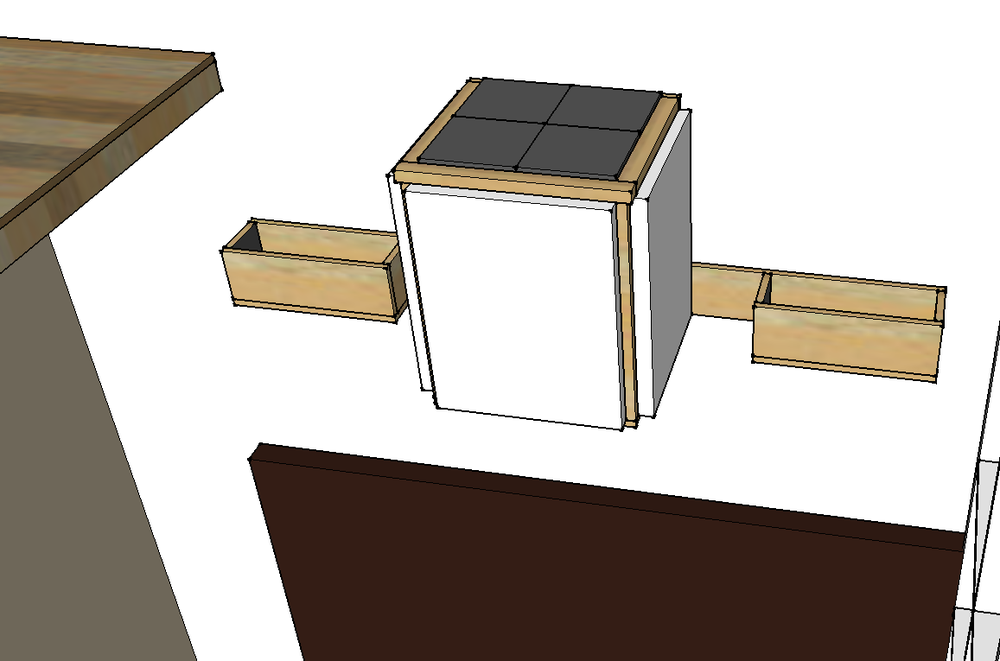
This is a “traditional” CR box approach with the 4 fans mounted together at the top, and the planters just hanging on the wall separately. I think the box sticking out of the wall looks a little weird, but I think this would be the most efficient option. Still, I don’t like it, so here’s another design:
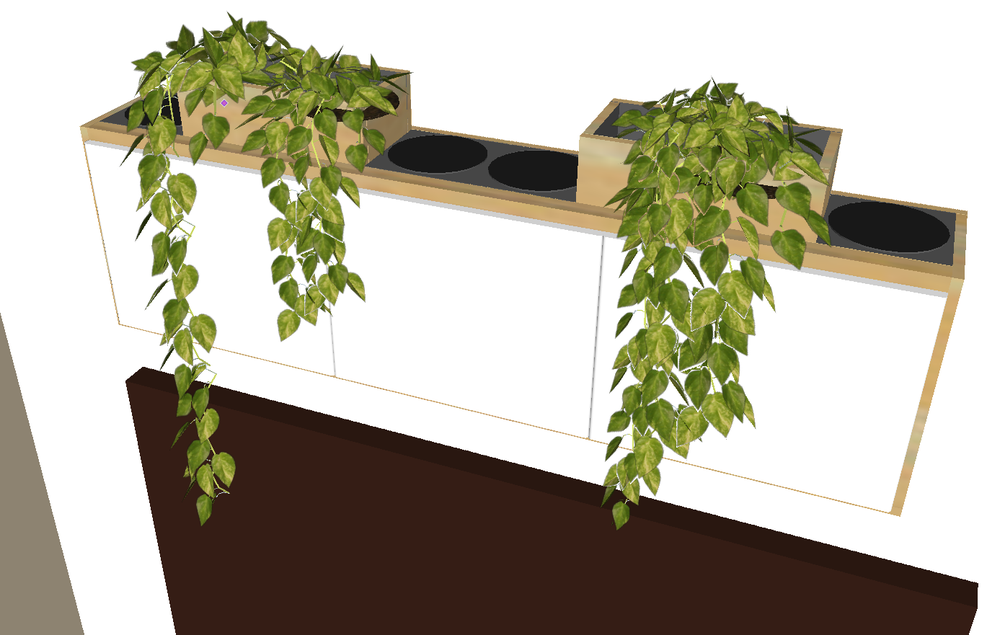
This one has the filters neatly mounted side by side, and the four fans on the top have two planter trays interspaced. This option is quite slim and has everything integrated. I think it would look nice with some vines trailing over the filters, although I should take care that they don’t grow into the fans.
One thing to keep in mind is that this is right over my head when I’m sleeping, so it needs to be very quiet. So another option is to design a “sound maze” by having the air flow around a baffle, and sound proofing the surfaces (drawn here in lavender):
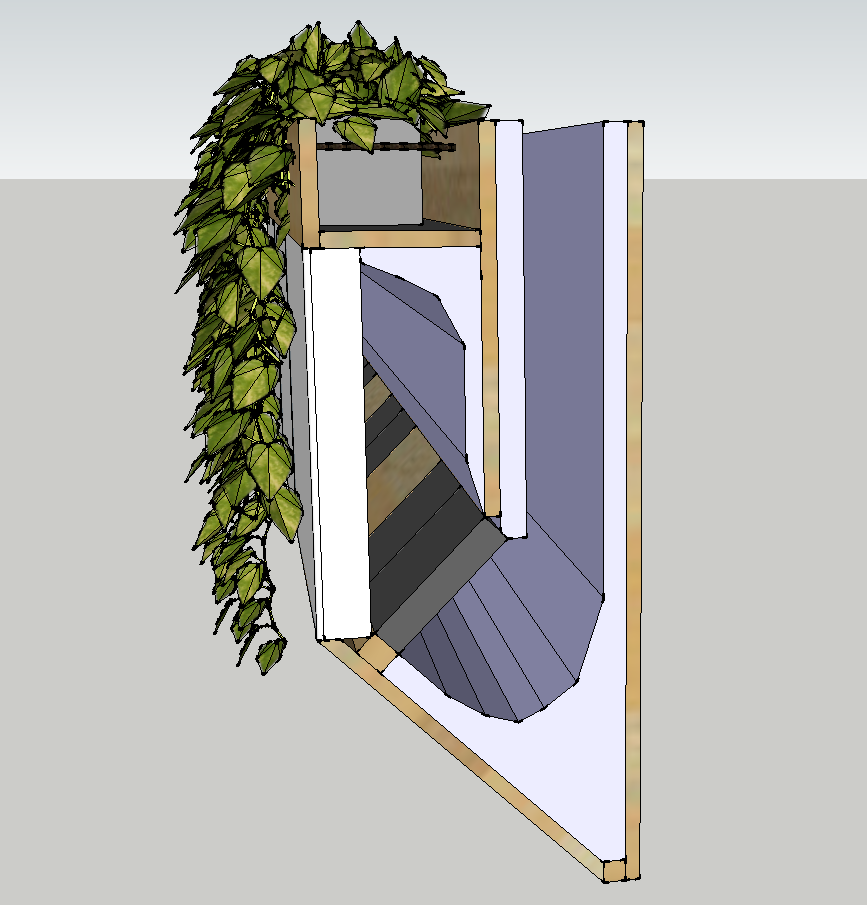
To keep the design somewhat narrow, it’d use 5-6x 12cm fans instead of 4x 14cm. An added benefit is that the plant tray runs the whole width, and plants are less likely to get into the fans:
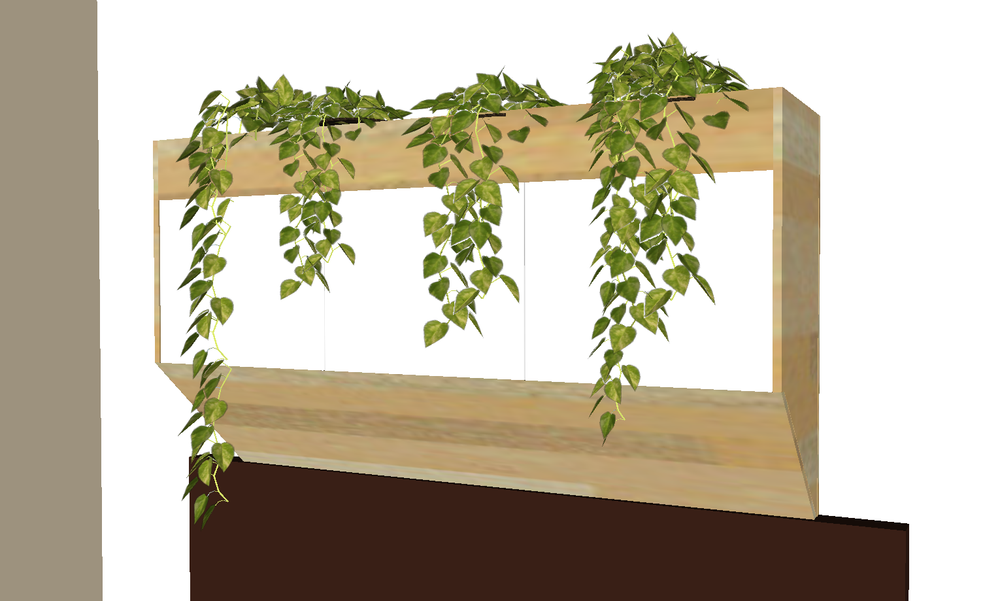
As a soundproofing material I’d use either cotton (low VOC) or sheep’s wool, which actually absorbs VOCs and is better with moisture. Perhaps use old wool blankets.
Quick budget calculations: €38.99 for the plywood, €35.97 for the filters, €24.79 for the fans, so about €100 in materials excluding sound proofing and a fan speed controller.
For fan speed control, I’m thinking of an ESP32 or Raspberry Pi controller, maybe also to log some sensor data and/or control lights in my room.
Some calculations. SergioCoscolin looked at a box with 2x Starkvind filters, and tested 3x Arctic P12 fans versus 5x the same fans. Results:
Fans CADR CADR/fan CADR/fan airflow 3x P12 143 m³/h 48 m³/h 51% 5x P12 173 m³/h 35 m³/h 37% Either 5 fans is running into diminishing returns for 2 filters, or perhaps the dual direction output is less efficient.
Let’s assume my design is a little less efficient because of the extra air path from the baffle, so let’s take the 70 m³/h per filter of the higher efficiency solution above, but assume a 40% CADR-per-fan-airflow. Since I’ve got 3 Starkvind filters, I’m aiming for 210 m³/h CADR (4 air chances per hour in my room), so 525 m³/h total fan airflow. That’s 5x P12 fans or 4x P14 fans on full speed.
I like the “dampened” design, but it’s quite big and I don’t like the 45 degree angles. Also, the filters in plain view will get dirty. Perhaps I could hide them. Here’s a simplified design with the filters behind a mesh covered front inlet slit:
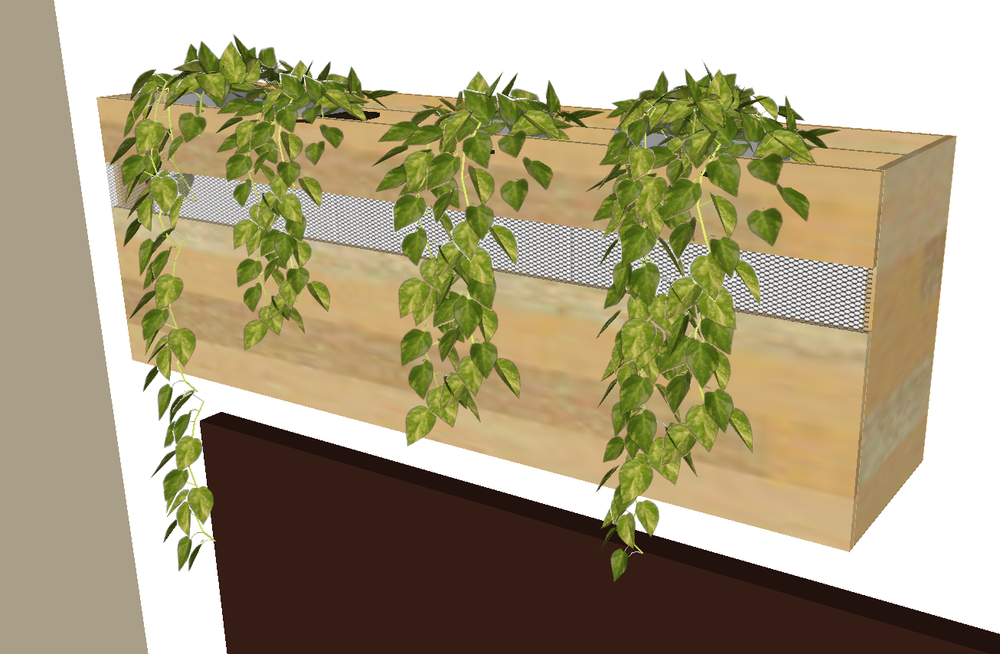
The inside is also simplified, with only right angle plywood. I haven’t drawn in any damping material but I think it could still fit. The front panel would need to hinge open, to be able to access the filters and fans, and it also clamps the filter in. This version uses 4x 14cm fans.
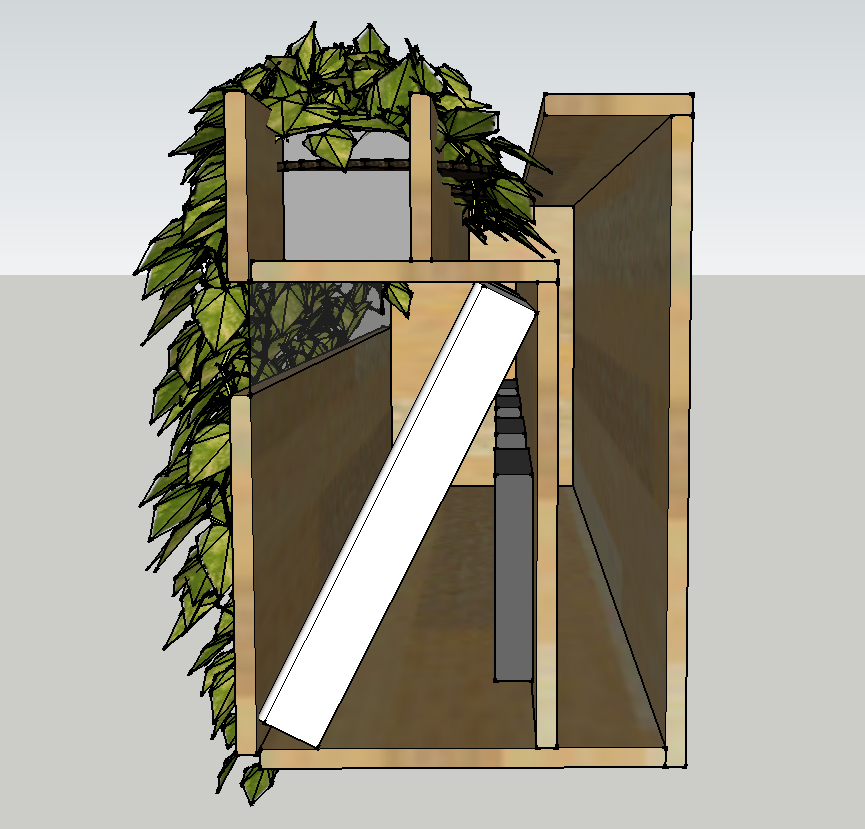
Next up I should do some static pressure calculations. The designs with baffle don’t make much sense if the added static pressure requires many extra fans to compensate the loss in airflow. In that case I’d probably just use a more airflow-efficient design with better fans, or just run at a lower speed.
Here’s a simpler more airflow efficient design with the 4x 14cm fans just pointing straight out the top. Air comes in through a mesh in the bottom. The bottom panel hinges to be able to access and clamp the filters.
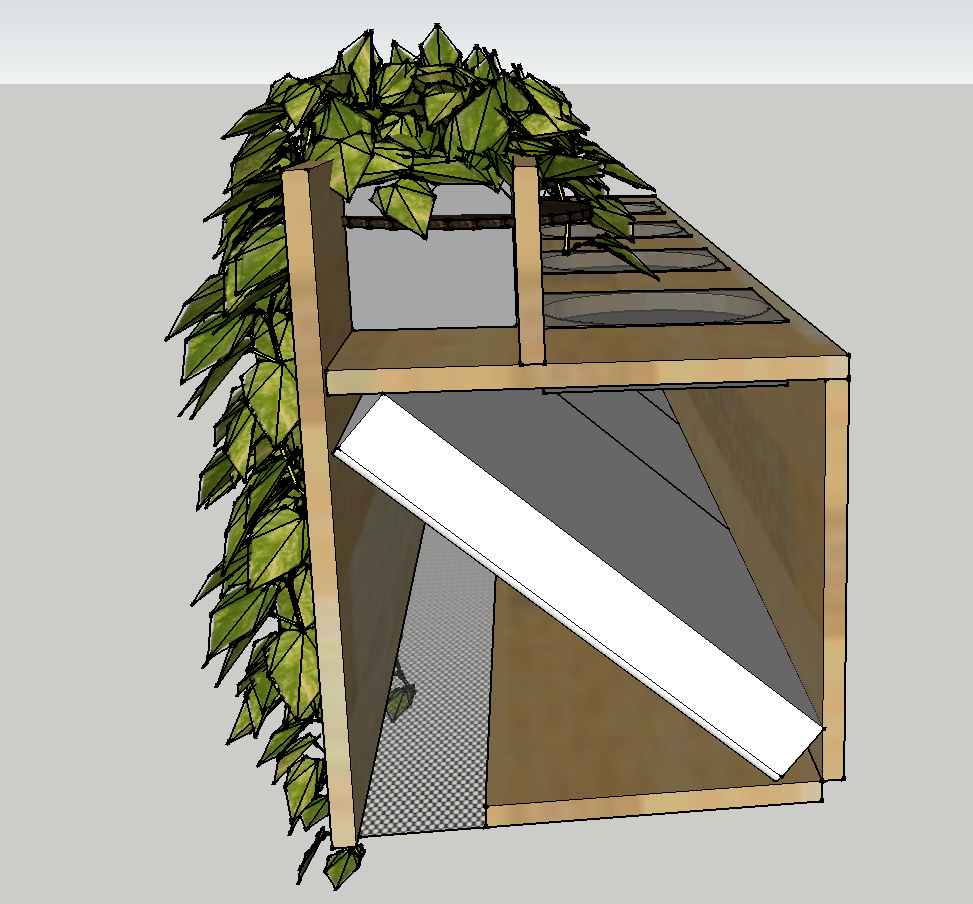
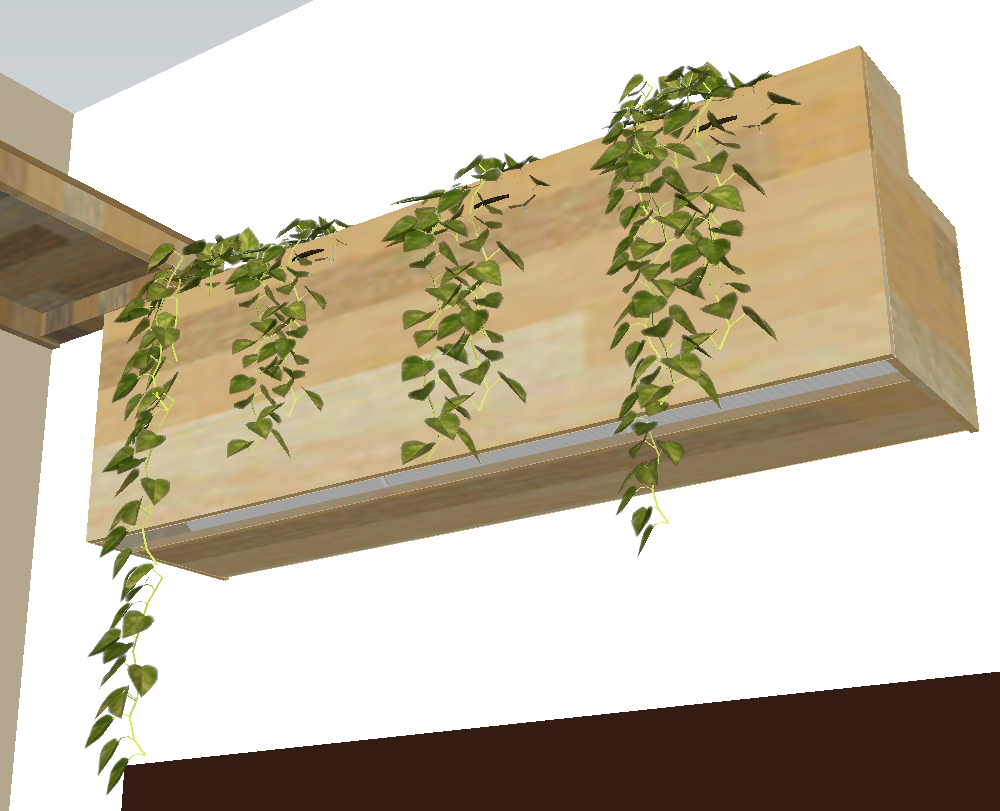
Ok, one more design. This is the above design expanded with a “hat” so I could include a baffle. The air comes in the bottom and goes out the front over the plants. I think this is the least flow impeding baffle design, and it has the added benefit of being able to put stuff on top of the thing.

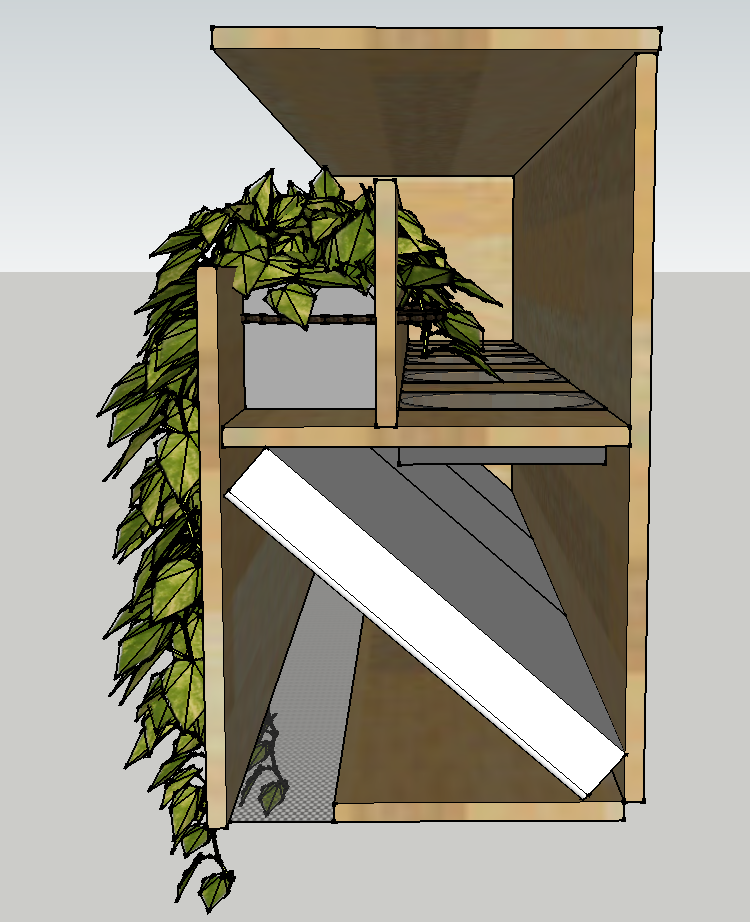
Oops, I forgot to draw in a flow diverting corner piece in the top right in this side view. Anyway, I think this is a pleasing design, especially if I use some of the same felt I used on my headboard as the top layer damping material.
I guess I could use the same mesh material used for the bottom opening in the top too, to prevent the plants from growing into the fans. Maybe attach both of the mesh pieces with little magnets, like an insect screen.
I could install GU10 downlights into the bottom panel. There’s enough space, and I don’t need to worry about the fittings leaking air since it’s before the filter.
I’m happy with this design! I guess I’ll skip the static pressure calculations.
Note to self: don’t use PVC pond liner to make the plant tray watertight; use something lower VOC like EPDM or PE. I think I might still have some 250 µm PE sheet.
- Heat recovery ventilation, continued
Humidity in my room is really starting to be a problem with all the plants I’ve got, and I haven’t even started up my active hydroponics systems or moss poles.
In a previous post, I looked at heat recovery ventilation to remove humidity without losing or gaining too much heat. I wrote that a ductless in/out “recuperator ventilation” system would be easiest/cheapest. Some thoughts:
- Efficiency is low, closer to 50% than the claimed 80-90%
- Decent units start around €300. Would be cheaper to just heat more and open the window in winter, or run a dehumidifier, though those wouldn’t solve hot & humid summer problems
- DIY would be difficult, because of the fan; most modern fans (including PC fans) can only run in 1 direction
- Soundproofing is difficult
So I’m going back to a counterflow heat exchanger idea. I previously looked at using a Stork heat exchanger unit, or perhaps repurposing only its core. However, that would be way too big for just my room, so I’m looking at making a smaller heat exchanger myself. I would still like it to be as efficient as possible. Main things that influence efficiency:
- Surface area of heat exchange
- Thickness of material
- Thermal conductivity of material
Maximum surface area is dictated by shape/construction of the exchanger and static pressure performance of the fans. To improve the other variables, I should use a material like copper aluminium, that is as thin as possible. I’m thinking aluminium foil like this DIY design that uses stacked panels clad in aluminium foil, or this design that uses 0.5mm aluminium sheeting folded in a zig-zag pattern.
I really like the aluminium foil panel design, but I should take care that condensation does not cause issues e.g. with mould, so I don’t think I should mount the foil on wooden frames. Perhaps something 3D printed could work. I would also use thicker industrial grade foil instead of household foil.
I should think about the space that is available, and how I can fit the core, insulation, fans, filters, perhaps a sound baffle etc. into that. Ideally have the two outlets as far apart as possible to prevent short circuiting, both inside the room and outside the window.
Here’s a first sketch of a compact unit using a 50x30x12cm core, clad in 4cm insulation and surrounded by a plywood shell that fits in the window opening. One 140mm fan would be mounted near the ceiling on a 220x54mm duct, while the other would come out sideways by the window. Or perhaps I could mount both fans on the housing and/or run the duct further out. The core would be made of 16 panels, each constructed out of 7.5mm PVC U-profile with slits for passing the air in between the foil.
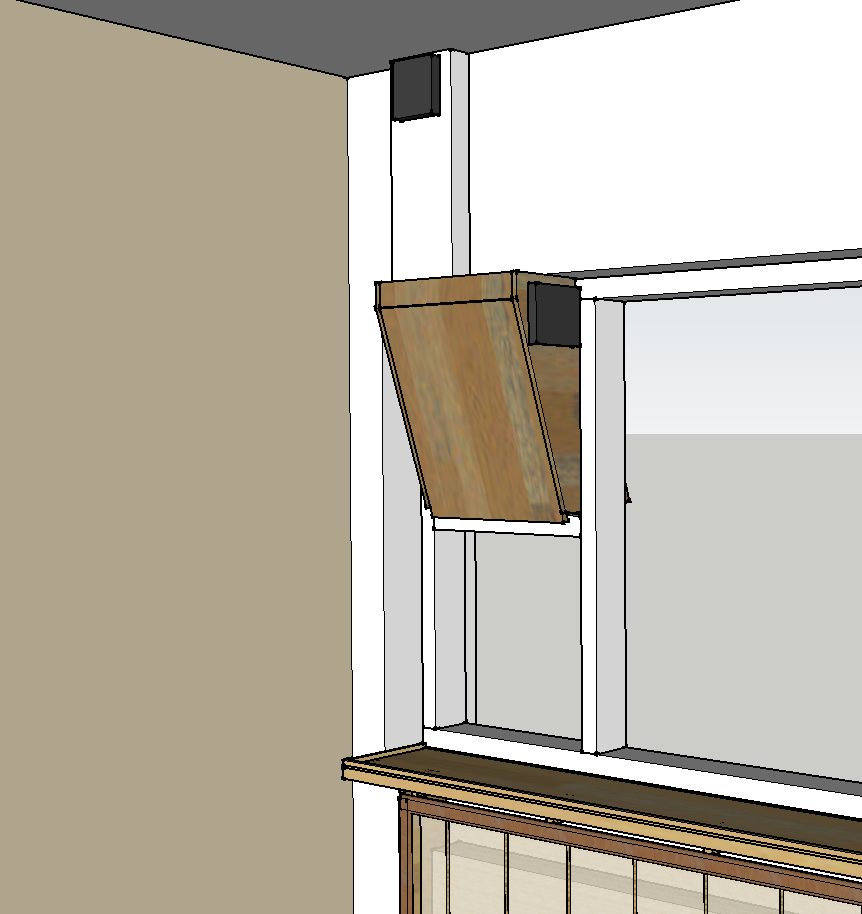
To be continued.
- Ventilation & air quality
I might need to ventilate more, but I would like to keep the heat in.
Some ideas:
- CO2 sensor & humidity sensor to know when to ventilate. I must still have a breadboarded project somewhere based on Operame
- Automatic window opener, perhaps based on this project?
- Heat recovery ventilation. The room I’d like to ventilate would require 25-72 m³/h. Some ideas:
- Something like a used Stork WHR90 (€100) unit could work, but it’s very large. I could mount the outdoor inlet and exhaust on a panel behind the wooden folding “window” already in the room. Should probably duct one of the indoors connections of the unit to the other side of the room to prevent short circuiting.
- A smaller heat exchanger with separate fans would likely be sufficient, and would be much smaller and easier to mount. Also, perhaps can be quieter, especially if mounted in an insulated box. However, it would likely be less efficient and probably more expensive.
- Something along the lines of this project or this one
- A heat recovery ventilation system using a single vent, with heat recovery material inside, blowing in/out alternately. Sometimes called “recuperator ventilation”. Less efficient, but simplest solution. A new unit can be had for about €150 but should also be the easiest to DIY, because the core doesn’t have to exchange heat through space, only over time. Ventilation (in/out) regime and thermal capacity should be matched carefully for highest efficiency, which means that throttling might not be possible. Commercial units use a ceramic core and roughly 70+70 second cycles. I guess instead of throttling, I could control the amount of cycles it does per hour based on the ventilation requirement. And/or use multiple temperature probes to control cycles? Ceramic cores are available: for instance this hexagonal one, and I wonder if this ceramic catalytic converter core substrate is suitable but might clog up too fast.
- To keep in mind: outside-to-inside noise reduction by installing a noise filter on the vents? And or acoustic insulation on the wooden window to lower fan-to-outside noise?
So far, the single fan “recuperator” seems the most viable option. Perhaps with a 12V case fan, and the whole thing encased in an insulated box mounted to the wooden window. And some filters. Or perhaps two units together in the box for a low/high flow option. Can even set it to just blow into the room at night on very hot days.
First, get a CO2 sensor working.